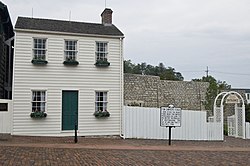Hannibal, Missouri
| Hannibal, Missouri | |
|---|---|
| City | |

Mark Twain's boyhood home in Hannibal
|
|
| Nickname(s): America's Hometown | |
 Location within Marion County (left) and Missouri (right) |
|
| Coordinates: 39°42′15″N 91°22′39″W / 39.70417°N 91.37750°WCoordinates: 39°42′15″N 91°22′39″W / 39.70417°N 91.37750°W | |
| Country | United States |
| State | Missouri |
| Counties | Marion, Ralls |
| Platted | 1819 |
| Incorporated | 1845 |
| Government | |
| • Type | City Manager and Council |
| • Mayor | James Hark |
| • City Manager | Jeff LaGarce |
| Area | |
| • Total | 16.21 sq mi (41.98 km2) |
| • Land | 15.74 sq mi (40.77 km2) |
| • Water | 0.47 sq mi (1.22 km2) |
| Elevation | 502 ft (153 m) |
| Population (2010) | |
| • Total | 17,916 |
| • Estimate (2012) | 17,814 |
| • Density | 1,100/sq mi (430/km2) |
| Time zone | CST (UTC-6) |
| • Summer (DST) | CDT (UTC-5) |
| ZIP code | 63401 |
| Area code | 573 |
| FIPS code | 29-30214 |
| GNIS feature ID | 0735640 |
| Website | City Website |
Hannibal is a city in Marion and Ralls counties in the U.S. state of Missouri. It is located at the intersection of Interstate 72 and U.S. Routes 24, 36, and 61, approximately 100 miles (160 km) northwest of St. Louis. According to the 2010 U.S. Census, the population was 17,606, making it the largest city in Marion County, although it is not the county seat. It is also the principal city of the Hannibal, Missouri micropolitan area, which consists of both counties.
The community is best known as the boyhood home of author Samuel Langhorne Clemens (aka Mark Twain) and as the setting of his The Adventures of Tom Sawyer and Adventures of Huckleberry Finn, with numerous historical sites related to Mark Twain and sites depicted in his fiction. Hannibal draws both American and international tourists. The Mark Twain Boyhood Home & Museum marked its 100th anniversary in 2012 and has hosted visitors from all fifty states and some sixty countries. Most Hannibal residents enjoy the visitors, and the town at large benefits from tourism revenue.
The site of Hannibal was previously occupied by early settlers and Native American tribes. It was laid out as a town in 1819 by Moses Bates, and named from Hannibal Creek (now known as Bear Creek). The name is ultimately derived from the hero of ancient Carthage, Hannibal. Although the city initially grew slowly to a population of only 30 by 1830, access to the Mississippi river and railroad transportation fueled growth to 2,020 by 1850. The town of South Hannibal was annexed to it in 1843. Hannibal had gained "city" status by 1845. The city served as a bustling regional marketing center for livestock and grain as well as other products produced locally, such as cement and shoes, throughout the remainder of the 19th century and on to the present time.
...
Wikipedia
